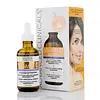What's inside
What's inside
 Key Ingredients
Key Ingredients

 Benefits
Benefits

 Concerns
Concerns

 Ingredients Side-by-side
Ingredients Side-by-side

Hippophae Rhamnoides Fruit Extract
Skin ConditioningMethylpropanediol
SolventGlycerin
HumectantNiacinamide
SmoothingDipropylene Glycol
HumectantSodium Hyaluronate
HumectantPEG-40 Hydrogenated Castor Oil
EmulsifyingCentella Asiatica Extract
CleansingPolygonum Cuspidatum Root Extract
AntioxidantScutellaria Baicalensis Root Extract
AstringentCamellia Sinensis Leaf Extract
AntimicrobialGlycyrrhiza Glabra Root Extract
BleachingChamomilla Recutita Flower Extract
MaskingRosmarinus Officinalis Leaf Extract
AntimicrobialPanthenol
Skin ConditioningBetaine
HumectantAscorbic Acid
AntioxidantHydroxyacetophenone
AntioxidantPentylene Glycol
Skin ConditioningCaprylyl Glycol
EmollientButylene Glycol
HumectantChlorphenesin
AntimicrobialCarbomer
Emulsion StabilisingArginine
MaskingDisodium EDTA
Pelargonium Graveolens Flower Oil
MaskingCymbopogon Martini Oil
MaskingCananga Odorata Flower Oil
MaskingCitrus Aurantium Bergamia Peel Oil
Rosa Damascena Flower Oil
MaskingHippophae Rhamnoides Fruit Extract, Methylpropanediol, Glycerin, Niacinamide, Dipropylene Glycol, Sodium Hyaluronate, PEG-40 Hydrogenated Castor Oil, Centella Asiatica Extract, Polygonum Cuspidatum Root Extract, Scutellaria Baicalensis Root Extract, Camellia Sinensis Leaf Extract, Glycyrrhiza Glabra Root Extract, Chamomilla Recutita Flower Extract, Rosmarinus Officinalis Leaf Extract, Panthenol, Betaine, Ascorbic Acid, Hydroxyacetophenone, Pentylene Glycol, Caprylyl Glycol, Butylene Glycol, Chlorphenesin, Carbomer, Arginine, Disodium EDTA, Pelargonium Graveolens Flower Oil, Cymbopogon Martini Oil, Cananga Odorata Flower Oil, Citrus Aurantium Bergamia Peel Oil, Rosa Damascena Flower Oil
Water
Skin ConditioningPEG-12 Dimethicone
Skin ConditioningAminopropyl Ascorbyl Phosphate
AntioxidantFerulic Acid
AntimicrobialLactic Acid
BufferingGlycolic Acid
BufferingGlycerin
HumectantPalmitoyl Tripeptide-1
Skin ConditioningPalmitoyl Tetrapeptide-7
Skin ConditioningAloe Barbadensis Leaf Juice Powder
Skin ConditioningTocopherol
AntioxidantHelianthus Annuus Extract
EmollientOryza Sativa Bran Extract
Skin ConditioningRosmarinus Officinalis Leaf Extract
AntimicrobialButylene Glycol
HumectantXanthan Gum
EmulsifyingPhenoxyethanol
PreservativeCaprylyl Glycol
EmollientHexylene Glycol
EmulsifyingEthylhexylglycerin
Skin ConditioningTetrasodium Glutamate Diacetate
Parfum
MaskingSodium Hydroxide
BufferingVanillin
MaskingMalonic Acid
BufferingCarbomer
Emulsion StabilisingSodium Lactate
BufferingPolysorbate 20
EmulsifyingLimonene
PerfumingLinalool
PerfumingCitronellol
PerfumingWater, PEG-12 Dimethicone, Aminopropyl Ascorbyl Phosphate, Ferulic Acid, Lactic Acid, Glycolic Acid, Glycerin, Palmitoyl Tripeptide-1, Palmitoyl Tetrapeptide-7, Aloe Barbadensis Leaf Juice Powder, Tocopherol, Helianthus Annuus Extract, Oryza Sativa Bran Extract, Rosmarinus Officinalis Leaf Extract, Butylene Glycol, Xanthan Gum, Phenoxyethanol, Caprylyl Glycol, Hexylene Glycol, Ethylhexylglycerin, Tetrasodium Glutamate Diacetate, Parfum, Sodium Hydroxide, Vanillin, Malonic Acid, Carbomer, Sodium Lactate, Polysorbate 20, Limonene, Linalool, Citronellol
 Reviews
Reviews

Ingredients Explained
These ingredients are found in both products.
Ingredients higher up in an ingredient list are typically present in a larger amount.
Butylene Glycol (or BG) is used within cosmetic products for a few different reasons:
Overall, Butylene Glycol is a safe and well-rounded ingredient that works well with other ingredients.
Though this ingredient works well with most skin types, some people with sensitive skin may experience a reaction such as allergic rashes, closed comedones, or itchiness.
Learn more about Butylene GlycolCaprylyl Glycol is a humectant and emollient, meaning it attracts and preserves moisture.
It is a common ingredient in many products, especially those designed to hydrate skin. The primary benefits are retaining moisture, skin softening, and promoting a healthy skin barrier.
Though Caprylyl Glycol is an alcohol derived from fatty acids, it is not the kind that can dry out skin.
This ingredient is also used as a preservative to extend the life of products. It has slight antimicrobial properties.
Learn more about Caprylyl GlycolCarbomer is a polymer of acrylic acid. Its main role is to create a gel consistency.
A high amount of carbomer can cause pilling or balling up of products. Don't worry, most products contain 1% or less of carbomer.
Glycerin is already naturally found in your skin. It helps moisturize and protect your skin.
A study from 2016 found glycerin to be more effective as a humectant than AHAs and hyaluronic acid.
As a humectant, it helps the skin stay hydrated by pulling moisture to your skin. The low molecular weight of glycerin allows it to pull moisture into the deeper layers of your skin.
Hydrated skin improves your skin barrier; Your skin barrier helps protect against irritants and bacteria.
Glycerin has also been found to have antimicrobial and antiviral properties. Due to these properties, glycerin is often used in wound and burn treatments.
In cosmetics, glycerin is usually derived from plants such as soybean or palm. However, it can also be sourced from animals, such as tallow or animal fat.
This ingredient is organic, colorless, odorless, and non-toxic.
Glycerin is the name for this ingredient in American English. British English uses Glycerol/Glycerine.
Learn more about GlycerinRosmarinus Officinalis Leaf Extract comes from rosemary. Rosemary is native to the Mediterranean.
While Rosmarinus Officinalis Leaf Oil can be volatile due to its fragrant properties, the fragrance components are usually removed in the leaf extract.
Rosemary Leaf Extract contains many antioxidants such as rosmarinic acid and caffeic acid. Rosemarinic acid, a compound found in rosemary leaf, has been found to help soothe skin conditions such as eczema and acne.
Learn more about Rosmarinus Officinalis Leaf Extract